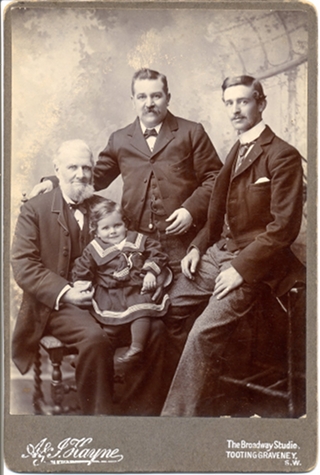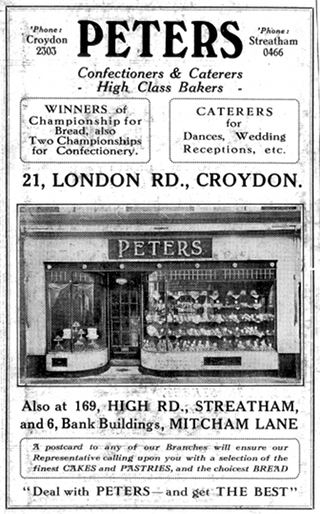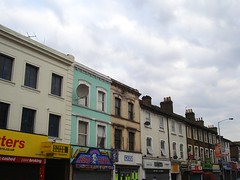21 London Road is the home of the somewhat confusingly-named Brixton, a Caribbean takeaway with a small eat-in area.
1830s–1870s: Sale of the land, construction of the building, and Henry Reed’s bakery
In the previous article in this series, I described the story of the building from when it was common land, through the sale of the land in 1835, the construction of the building in the mid-1860s, and finally the opening of the first business around 1864: Henry Reed’s bakery.
The goods on offer at Reed’s are described in street directories of the time[1]: “the Celebrated ALICE and CHARCOAL BISCUITS[2]”, “wedding and school cakes”, “ices, jellies, British wines”, “superior nursery biscuits”, and “French and Hungarian Fancy and Tea Bread”.[3]

1870s–1890s: Arthur Shears and William Robert Shears
Henry Reed remained on London Road until around the end of the 1870s, when he was replaced by Arthur Shears, a master baker who moved to Croydon from Newington some time between 1878 and 1880. Arthur’s son William Robert Shears moved along with him, to work as his assistant in the bakery business. Arthur and his wife Elizabeth lived at 21 London Road, while William Robert and his wife Eliza lived with their children just around the corner at 7 Mead Place.[4]
The bakery passed from Arthur to William Robert around 1895.[5] However, William Robert moved his branch of the family to Tooting four or five years later, while Arthur and Elizabeth, now pensioners, moved to the London Master Bakers Benevolent Association almshouses in Leyton.[6]
William Robert and his son William Arthur continued to work as cooks in Tooting, though the 1901 census lists them as workers rather than employers. According to research carried out by Bill Shears (Arthur Shears’ great-great-grandson), it’s likely that they worked at Peter Jung’s baker’s shop at 48 Tooting High Street.[6a] The London Road business was taken over by Peter Masters, who remained at the premises until around 1905.[7]


1900s–1920s: Frederick and Blanche Wylie
Next came Frederick W Wylie and his wife Blanche Wylie. Ward’s street directories for 1906, 1907, and 1908 list Frederick as the cook and confectioner in charge; however, Frederick died in January 1908 at the age of 36,[8] and his widow took over the business.
Blanche Wylie was also only in her mid-thirties at this point, and Frederick’s death left her widowed for the second time.[9] By the time of the 1911 census her household included a 12-year-old son from her first marriage, John Henry Gadd, and a 3-year-old daughter from her second, Dorothy Vera Wylie. Her widowed father, George Dunn, and her sister, Gertrude Clara Dunn, are also listed at 21 London Road, though given that census data is merely a snapshot in time it’s not clear whether they were living there permanently.
Like her late husband, Mrs Wylie was listed in Ward’s street directories as a cook and confectioner. An advertisement in The Croydon Recipe Book, published in June 1912, notes that one of her specialities was Scotch pancakes,[10] “To be eaten hot or cold, with butter, jam or fruit.”
1920s–1980s: Peters Bakery
Blanche Wylie remained at 21 London Road until around 1925.[11] Her successor bore a name which was to be associated with London Road for a good six decades. Arthur Peters made his first Croydon appearance in Ward’s 1926 street directory, and just three years later he was proudly advertising his business as having won championship competitions for both bread and confectionery (see advert here).
While the business changed hands a few times over the subsequent years, it continued to trade as Peters bakery until around 1985,[12] and is still a familiar name to many people in Croydon today. Below is an excerpt of a conversation[13] I had earlier this year with Shirley Locke and her son Clive, both long-term residents of Croydon.
SHIRLEY: Along here there used to be a lovely cake shop, Peters.
KAKE: Peters the baker, number 21.
SHIRLEY: Yeah, that's right, that was lovely.
CLIVE: And I remember, my family, my nan's sister, had a Canadian... she married a Canadian, and he used to come over, and we were tiny, he was quite a celebrity, being Canadian... it was quite a nice thing to have a Canadian in the family.
SHIRLEY: He was lovely too, yeah.
CLIVE: And he would always just go to Peters and buy cream cakes, every time he was over, he used to come round with boxes of them. He thought it was...
SHIRLEY: He got me on the cream slices! [laughs] When I was pregnant with my third son. [laughs] I never had cream cakes before that.
(Update, January 2014: After I first published this article, Terry Coleman commented to say: “My memory of Peters Bakery was an impressive three or four tier wedding cake that always seemed to be on display in that rounded shop window. We had our wedding cake made there in 1974.”)
Peter Coughlan of the Coughlan baking family also remembers Peters: “It was always known as Peters Bakery and was the best one shop business in the area. All products were baked on the premises. It was sold a couple of times and the last owner to trade as Peters was Fred Harris who had a bakery business in London. I think it closed down when Fred retired or died in 1985.”[14]
1980s–1990s: Coughlans
The name “Coughlan” is another one that should be familiar to Croydon residents who’ve made purchases from this local bakery chain. The business was founded in 1937, initially with just two snack bars at 739 London Road and at 102 The Broadway in Wimbledon. The company expanded over the years and today has over 20 shops in and around Croydon and Thornton Heath.[15]
Coughlans took over 21 London Road after Fred Harris left in 1985, remaining there for just over 15 years. Peter Coughlan recalls: “We took on a new lease in June 1985 only to find that the level of trade was nowhere near it used to be and we had committed to a 25 year lease! Fortunately we managed to assign the lease in February 2002 to a Mr Argibas who completely renovated the whole premises and the old bakery as well to use the retail area as a Fish & Chip Shop.”[16]
2000s: Doneagles and Take Two
The abovementioned fish and chip shop was likely Doneagles, listed at 21 London Road in the May 2002 Goad plan. By July 2008, it had become Take Two, a Caribbean restaurant, cafe, or takeaway — I haven't been able to find out which.[17] Around the end of 2010, the lease changed hands again and Brixton opened.[18]
c.2010–present: Brixton
Today, Brixton Caribbean takeaway is open seven days a week from 7am to midnight, offering Caribbean food from liver & banana for breakfast to mannish water on the weekends.[19]
Thanks to: Brian Gittings; Clive and Shirley Locke; Elly at the Vintage Cookbook Trials; Howard at Brixton; Peter Coughlan; all at the Croydon Local Studies Library; and my beta-readers bob and Henry. Census data, National Probate Calendar, FreeBMD indexes, and 1916-2007 Death Index consulted via Ancestry.co.uk.
Footnotes and references
- Warren’s 1869 directory and Ward’s 1876 directory.
- I haven’t been able to find out what Alice biscuits were, though Henry Braun suggests a connection with Alice in Wonderland, which “was a bestseller of the time: it came out in 1866 and 12,000 copies had been printed by 1868. There aren’t any biscuits in the book, though they appear in Through The Looking Glass of 1871.” (online conversation, July 2013). According to Alan Davidson’s Oxford Companion to Food, charcoal biscuits were “eaten in the 19th and early 20th centuries as an antidote to flatulence and other stomach troubles” and were “based on ordinary flour mixed with powdered willow charcoal, made into plain dough with a little butter, sugar, and eggs”.
- It isn't entirely clear how “French and Hungarian Fancy and Tea Bread” should be parsed, but I'm taking it to mean “fancy bread and tea bread in French and Hungarian styles”. According to John Kirkham's The Baker's ABC (published in 1927), the term “fancy bread” had both a common meaning and a technical meaning. The common meaning was “any sort of loaves or rolls that are different in form or appearance, or in composition, from plain bread”, for example loaves that were “glazed, or notched, or contain above the normal proportion of fat, or milk, or sugar, or eggs, or other enriching material”. The technical meaning, however, was bread which was exempt from the requirements of the 1822–36 Bread Acts that bread should be sold by weight. Kirkham adds that “French bread” at the time of the 1822 Act was “made in rolls, wholly crusty, and in cases baked hard, and then rasped”. A separate entry in the same book describes Hungarian flour as being milled in Budapest from Romanian-grown wheat using the roller milling system, and says it was imported to Britain in quantity until the First World War. Moreover, the entry notes that its reputation for quality was due to the Hungarian millers' early adoption of the roller milling system, which was superior to other technologies of the time. (The Baker's ABC consulted via a copy owned by Elly of The Vintage Cookbook Trials.)
- In the 1861 census, Arthur Shears (age 36, born in Byfleet) is living at 48½ Francis Street, Newington, with his wife L. Eliza Shears (age 38) and children including William R. Shears (age 5). He's a master baker employing one man and one boy. In the 1881 census, Arthur and his wife (possibly not the same wife; this one is called Elizabeth and is 7 years younger than him rather than 2 years older) are at 11 London Road (later renumbered to 21); he’s a baker employing five men and two boys. William Robert Shears (age 25) and his wife Eliza (age 21) are at 7 Mead Place with children William A Shears (age 2, born in Newington) and Elizabeth E Shears (age 4 months, born in Croydon). William Robert is listed as “Baker — assistant to father”. Hence William Robert must have moved to Croydon between the birth of William A and the year of the census, i.e. between 1878 and 1881, and it seems likely that he moved at the same time as his father, to continue in the bakery business. The first appearance of Arthur Shears in Croydon street directories is in Ward’s 1880.
- Arthur Shears is listed in Ward’s and Kelly’s street directories from 1880 to 1895 inclusive. Kelly’s directories list him simply as a confectioner, while Ward’s list him as a baker and confectioner until 1887 and as a cook and confectioner from 1888 onwards. It’s not clear whether this signifies a change in the business or a change in Ward’s categorisation scheme. William Robert Shears, cook and confectioner, is listed in Ward’s directories from 1896 to 1899 inclusive.
- As noted in footnote [5], William Robert Shears last appears in Croydon street directories in 1899. The 1901 census lists William Shears (age 45, born in Newington) and Eliza Shears (age 41, born in Brixton) at 51 Gilbey Road in the Civil Parish of Tooting Graveney with their children including William Shears (age 22, born in Newington) and younger children born in Croydon; this is clearly our William Robert Shears. Father and son are listed as cooks — workers, not employers — and the household appears not to include any live-in servants. In the same census, Arthur and Elizabeth Shears (ages 76 and 69 respectively, born in Byfleet and Woking respectively, which matches with their entries in the 1881 and 1891 censuses) are living at number 52, Lea Bridge Road Almshouses, in the Civil Parish of Leyton. He is listed as a pensioner. These almshouses were built between 1857 and 1866 by the London Master Bakers’ Benevolent Institution for persons who had retired from the baking industry. See This Is Local London and Hidden London for more. Taking William Shears’ lack of servants and status as a worker rather than an employer, along with Arthur Shears’ residence in an almshouse (which is a form of charitable housing), it seems that the family’s fortunes had diminished.
- According to Bill Shears, Elizabeth Eliza Shears (daughter of William Robert Shears) married Heinrich Bender (nephew of Peter Jung). Bill knew Heinrich as “Uncle Harry”. He tells me (via email, January 2014): “I can’t confirm that William Robert or his son worked at the Jung shop, but I think the circumstantial evidence is quite strong. It seems likely that Elizabeth Eliza met Harry as a result of WR [William Robert] and WA [William Arthur] working at the shop rather that the other way round.” The address of the shop comes from a record in the Wandsworth Heritage Service online catalogue, which as of early 2021 is apparently no longer online; but when it was, it listed a photograph (ref D105/8/164) of “the shop front of Peter Jung, baker, 48 Tooting High Street”.
- Peter Masters, cook and confectioner, appears at 21 London Road in Ward’s street directories from 1900 to 1905 inclusive.
- The National Probate Calendar (Index of Wills and Administrations) 1858-1966 states: “WYLIE Frederick William of 21 London-road Croydon Surrey died 24 January 1908 Administration London 29 May to Blanche Elizabeth Wylie widow. Effects L1144 13s. 3d.” The FreeBMD Death Index 1837-1915 states that Frederick was 36 at the time he died.
- The 1901 census lists Blanche E Gadd as a 29-year-old widow, working as a confectioners manageress and living in the household of her father, George Dunn, at 30 Caledon Road, East Ham. George’s grandson, John H Gadd (obviously Blanche’s son) is also listed. According to the FreeBMD Marriage Index 1837-1915, Blanche Gadd and Frederick Wylie were married in late 1904 in East Ham. It’s possible that they could have met via both working as confectioners, though I haven’t managed to find Frederick in the 1901 census so I don’t know what his profession actually was at the time.
- The Croydon Recipe Book is available under shelfmark s70 (640) TOD at the Croydon Local Studies Library. Scotch pancakes are also known as drop scones or dropped scones. They’re smaller and thicker than other types of pancakes, and are cooked on a greased griddle onto which dollops of a thick creamy batter are dropped, hence the name. (Some of this information comes from Alan Davidson’s Oxford Companion to Food, the rest from personal experience. I remember cooking drop scones with a friend while aged around 11 or so. They came out beautifully.)
- “Mrs Wylie, cook and confectioner” is listed in Ward’s street directories from 1909 to 1925 inclusive. I don’t know what happened to her after she left London Road, but she could well be the Blanche E Wylie listed in the England & Wales Death Index 1916-2007 as dying at age 72 in mid-1943 in Bromley — an age of 72 in 1943 is perfectly consistent with an age of 29 in 1901 (see footnote [9]).
- Ward’s street directories list Arthur Peters, cook and confectioner, from 1926 to 1932 inclusive and A Peters, confectioner, in 1934, 1937, and 1939. Kent’s 1955 and 1956 directories list A Peters, bakers & confectioners. “Peters” (no initial) is listed in the 1967, 1971, and 1974–5 editions of the Croydon Classified Directory; the 1968 Croydon and District Green Guide; the August 1974, March 1983, March 1984, April 1986, and April 1987 Goad plans; and the 1986–87 and 1988–89 editions of the London Shop Surveys. Note the discrepancy here with the information provided by Peter Coughlan, who states that Coughlans took over from Peters in 1985. Mr Coughlan confirmed to me via email that Coughlans traded under their own name from the start. This isn’t the first time I’ve suspected inaccuracies in the Goad plans; see for example footnote [23] in my article on 20 London Road.
- Audio-recorded conversation on 20 March 2013.
- Via email, 28 March 2013.
- Information on Coughlans taken from the Coughlans website and from an advertising feature in the Croydon Post of 11 November 1987 (the latter consulted via a clipping in the Coughlans firm file at Croydon Local Studies Library). I’ll cover Coughlans at greater length when I get further up London Road.
- Via email, 28 March 2013. Peter Coughlan adds that Mr Argibas “used the back area for a different use — I did see it but can't remember what it was, I think maybe some kind of school.”
- At the time of writing, there's a useful Google Street View anomaly at this end of London Road. Most of the London Road images are from May 2012, but there's a single spot just outside the Ship of Fools where it reverts back to July 2008; in this, “Take Two” is just visible on the frontage of number 21. Several restaurant-listing websites still have Take Two listed at 21 London Road, including Sugarvine, which makes it clear that this was also a Caribbean place.
- Conversation with Howard, who works at Brixton, on 17 July 2013. Howard told me that Brixton opened “about two and a half years ago”, and before that it was Take Two. He also told me that Brixton has no connection with Take Two — “different leaseholder” — and that it's not part of a chain; this is the only branch.
- See photo of takeaway menu. I’ve had the liver and bananas, but not yet tried the mannish water (which is a type of goat soup).

